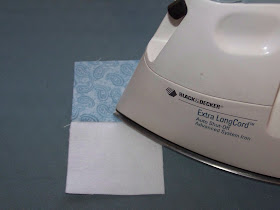Lesson 2 -- Fabric
Lesson 3 -- Cutting Fabric
Lesson 4 -- Piecing
Lesson 5 -- Piecing the Blocks Together
It's now time to add the borders and complete your quilt top!
If you have not done so already, choose a fabric that you would like to use for your borders. I have included two borders in my design -- a narrow inner border and a wider outer border.
"Audition" fabrics by laying them next to your quilt top. Then take a step back to see how they look. I actually did this step before sewing all the blocks together.
Once you have chosen your fabrics, cut the border strips. Cut these in the same manner as you cut the strips for your pieced blocks.
 |
| The fold is along the bottom here. |
Fold the fabric in half (matching selvage edges).
Line the ruler up on the fold, cut a small strip off to square up the fabric, then measure and cut your strips. For the inner border, cut the strips 1 3/4" wide.
Cut 4 strips -- one each for the top, sides, and bottom. If you would like to add the corner blocks to the border (see quilt layout photo above), you will also need to cut 4 - 1 3/4" squares. I used a yellow scrap piece of fabric that was leftover from the nine-patch blocks.
Lay out the strips with your quilt to make sure they are long enough.
Sew the side borders on first. With right sides facing each other, pin one of the side borders to the quilt top. Your border strip should be a little longer than your quilt. Leave a little extra at each end. You will trim it off evenly after attaching the border. Sew the border to the quilt top using a 1/4" seam allowance.
Before pressing, lay the quilt facing down on your cutting surface, line up a ruler with the corner of the quilt, and trim the border to the exact length of your quilt.
Press the seam allowance toward the border fabric.
Repeat this process for the opposite side border.
If you are not sewing corner blocks, you can go ahead and sew the top and bottom borders on in the same manner as the sides. Then skip ahead to Lesson 7 -- Outer Border.
If you are going to add the corner blocks to your inner border, follow these steps:
First square up one end of your top strip by lining up a ruler and trimming off a little bit. Take one of the corner squares and, with right sides facing, lay it on top of the border strip being sure to line up the edges. Sew the square to the strip with a 1/4" seam allowance. Press the seam toward the border fabric.
Now take the border strip and lay it in position on your quilt, making sure to carefully line up the seams (see photo at right).
You are now going to line up the opposite end of the strip and trim it to the exact length you will need.
Be sure to measure accurately in this next step! Line up the 1/4" line on the ruler with the seam from the side border.
Use a marking tool to draw a line on the top border along the edge of the ruler.
Your top strip needs to be trimmed so that it is equal to the width of the quilt, plus 1/4" seam allowance because you will need that seam allowance to attach the other corner square.
Trim the strip by cutting it along the line you just drew. Then sew the second corner square to the top border strip in the same manner as you did the first one.
 |
| Top left corner of quilt |
Press the seam toward the border fabric.
 |
| Top right corner of quil |
Repeat these steps for the bottom border strip.
The inner border is now complete!
In Lesson 7 we will add the outer border.











































